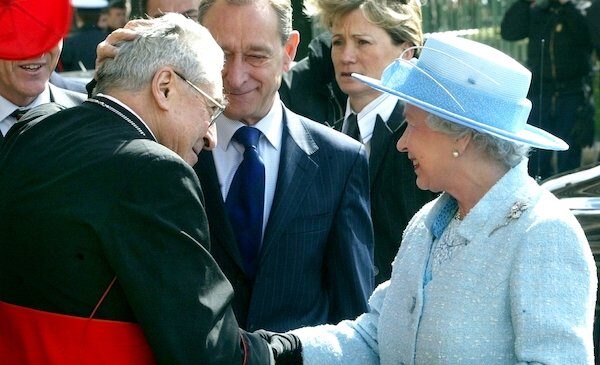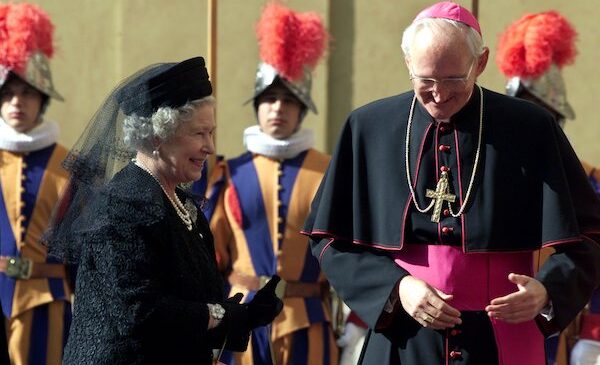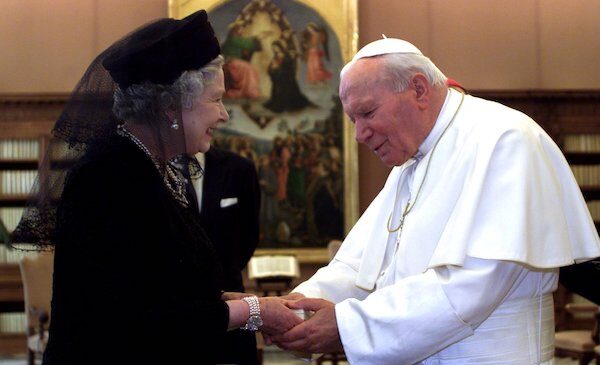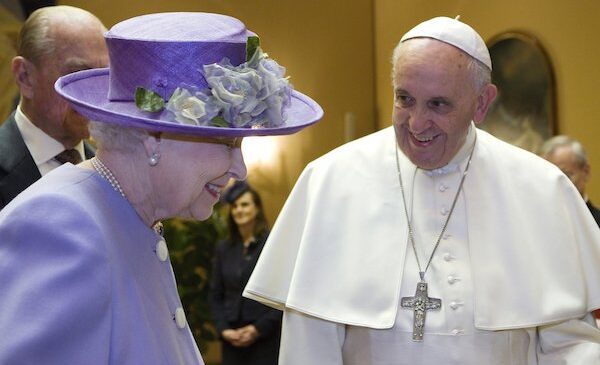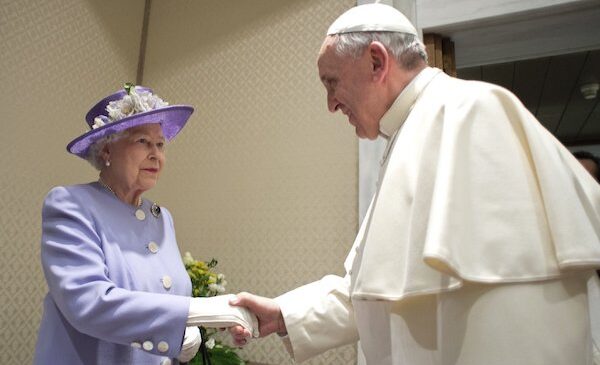PROSPECT HEIGHTS — Queen Elizabeth II died Thursday evening with the royal family by her side after doctors expressed concerns about her deteriorating health earlier in the day.
Pope Francis, who met with the queen in 2014, said he was deeply saddened to learn of the queen’s death and offered his “heartfelt condolences” to the Royal Family, U.K., and the Commonwealth.
“I willingly join all who mourn her loss in praying for the late Queen’s eternal rest, and in paying tribute to her life of unstinting service to the good of the Nation and the Commonwealth, her example of devotion and duty, her steadfast witness of faith in Jesus Christ and her firm hope in his promises,” Pope Francis said in a telegram to King Charles III, who ascended to the throne the moment the queen passed away.
Queen Elizabeth, who was 96 and reigned for 70 years, was placed under medical supervision Thursday morning at Balmoral Castle in Scotland. At 6:30 p.m. local time, Buckingham Palace released a statement announcing her death: “The Queen died peacefully at Balmoral this afternoon. The King and The Queen Consort will remain at Balmoral this evening and will return to London tomorrow.”
In a statement, the head of the Catholic Bishops’ Conference of England and Wales called the queen “a shining light in our history.”
“We are heartbroken in our loss at her death and so full of admiration for the unfailing way in which she fulfilled that declaration,” Cardinal Vincent Nichols, Archbishop of Westminster, said in the statement. “Even in my sorrow, shared with so many around the world, I am filled with an immense sense of gratitude for the gift to the world that has been the life of Queen Elizabeth II.”
King Charles is expected to speak to the nation on Friday. He issued a brief statement Thursday evening, saying the queen’s death “is a moment of the greatest sadness for me and all members of my family.”
“I know her loss will be deeply felt throughout the country, the Realms and the Commonwealth, and by the countless people around the world,” King Charles said.
In the telegram sent to King Charles, Pope Francis assured the new king of his “prayers that Almighty God will sustain you with his unfailing grace” as he takes his place on the throne.
“I invoke an abundance of divine blessings as a pledge of comfort and strength in the Lord,” Pope Francis said.
In June, the United Kingdom celebrated Queen Elizabeth’s Platinum Jubilee, marking the 70-year milestone. She is England’s longest-serving monarch, having taken the throne in 1952 at the age of 25 after the death of her father, King George VI.
Though Queen Elizabeth and the royal family are members of the Anglican Church, Nichols noted her strong faith and how it came through in her public messages.
“This faith … has been an inspiration to me, and I am sure to many,” Cardinal Nichols said. “The wisdom, stability, and service which she consistently embodied, often in circumstances of extreme difficulty, are a shining legacy and testament to her faith.”
Bishop Hugh Gilbert of Aberdeen, President of the Bishops’ Conference of Scotland, said the queen’s reign “stands as an example of dedicated public service in our own country, across the commonwealth and around the world.”
“Her determination to remain active to the end of her long life has been an example of Christian leadership, which demonstrated her great stoicism and commitment to duty and was undoubtedly a source of stability and continuity in times of great change,” Bishop Gilbert said in a statement.
Queen Elizabeth met with five popes in her lifetime — four during her reign and one (just) before she took the throne.
The most recent visit between the queen and a pope was in 2014 when she welcomed Pope Francis to Buckingham Palace. The meeting marked the 100th anniversary of the re-establishment of diplomatic relations between the United Kingdom and the Holy See.
At the meeting, Queen Elizabeth gifted Pope Francis a wicker basket full of local delicacies — including a dozen eggs and two types of honey — and a bottle of whiskey. Returning the gesture, Pope Francis gave the queen a blue crystal sphere, with a silver cross of Edward the Confessor, as a gift for the queen’s then- eight-month-old great-grandson, Prince George of Cambridge.
Four years prior, in 2010, Pope Benedict XVI and Queen Elizabeth met at Buckingham Palace during the pontiff’s trip to England to beatify then-Cardinal John Henry Newman. At the time, Pope Benedict described the meeting as “cordial” and “characterized by the sharing of several profound concerns for the well-being of the world’s peoples and for the role of the Christian values in society.”
Before Pope Benedict, Queen Elizabeth met Pope John Paul II three times. The first was in 1980 at the Vatican, the second in 1982 at Buckingham Palace, and the third back at the Vatican in 2000.
The 1980 visit was Queen Elizabeth’s second papal meeting as queen, following a meeting with Pope John XXIII in 1961.
Queen Elizabeth did, however, meet a pope before taking the throne. She met with Pope Pius XII in 1951, a year before her ascension to the throne.
As queen, Elizabeth was the sovereign of 14 Commonwealth realms and the UK. These include Antigua and Barbuda, Australia, Bahamas, Belize, Canada, Grenada, Jamaica, New Zealand, Papua New Guinea, Saint Kitts and Nevis, Saint Lucia, Saint Vincent and the Grenadines, Solomon Islands, and Tuvalu.
She was also head of the Commonwealth itself, a voluntary association of 54 independent countries — 21 African, 8 Asian, 13 in the Americas and the Caribbean, and 11 in the South Pacific.
Now that the queen has died, Cardinal Nichols said the conference prays “for the repose of the soul of Her Majesty.”
“Our prayer is that she is now received into the merciful presence of God, there to be reunited with her beloved Prince Philip,” he said. “This is the promise of our faith and our deep consolation.”

